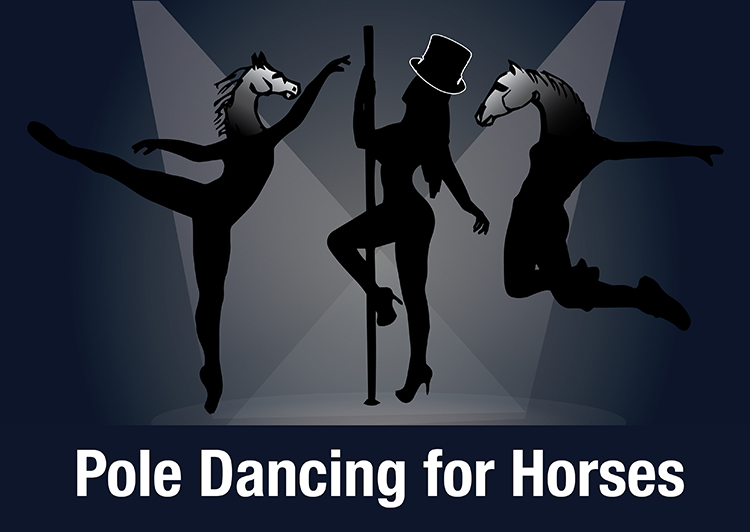
Pole Dancing to improve your dressage! with Lesley Brodbeck
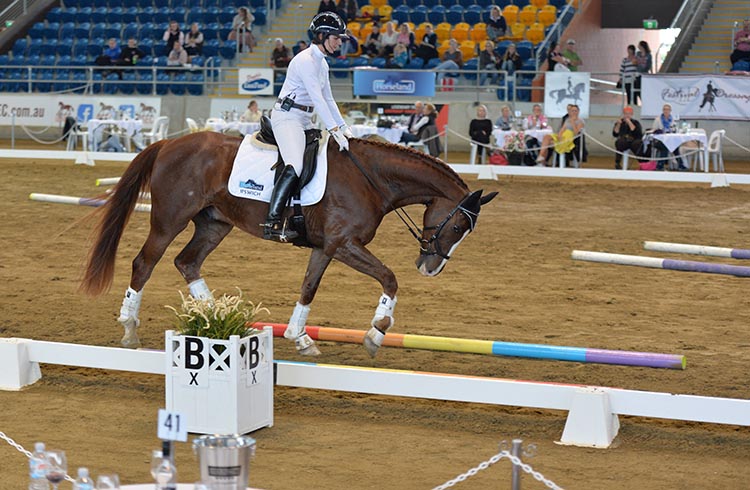
Chris Hector sits in on a stimulating exercise session at the Queensland Festival of Dressage with Lesley Brodbeck…
Lesley has been producing and competing event horses for over thirty years. She has trained many horses through to three-star level and has been a member of several elite riding squads.
Lesley is a BHS and NCAS accredited coach, and an Australian 3DE representative.
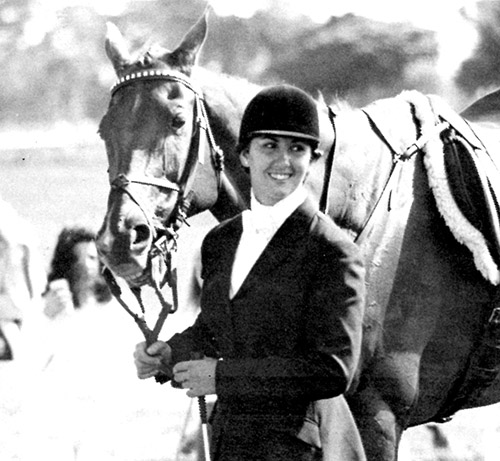
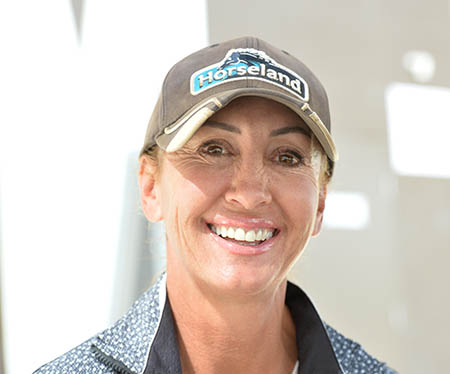
These days, Lesley is very involved with the Interschool movement and coaches for Stuartholme Girls school in Brisbane and has trained many horse/rider combinations through the grades. Lesley also coaches and competes from her base in Moggill, Queensland, where she runs an agistment and training centre.
They are unlikely candidates for the pole dancing scene, Liz Owens and her huge, five-year-old Diamond Hit gelding, Diamond Jubilee. Liz tells us, ‘he’s out of a Jive Magic mare, and the line traces back to Gyulla Dallos’ lovely grey stallion Aktion, which has some historic appeal for me as I trained with Gyulla in Budapest.’
Lesley Brodbeck is someone who is prepared to think outside the square, or rectangle – literally – and she and Liz have collaborated on a series of exercises using poles to improve the horse’s athletic ability, and the rider’s ability to coördinate.
Lesley warns the spectators at Queensland’s Dressage Festival – “pole work is deceiving, it looks easy but in fact it is quite demanding. Diamond Jubilee is built uphill, and this first exercise is to encourage longitudinal stretch, the poles help him focus down and out.”
Next the exercises –
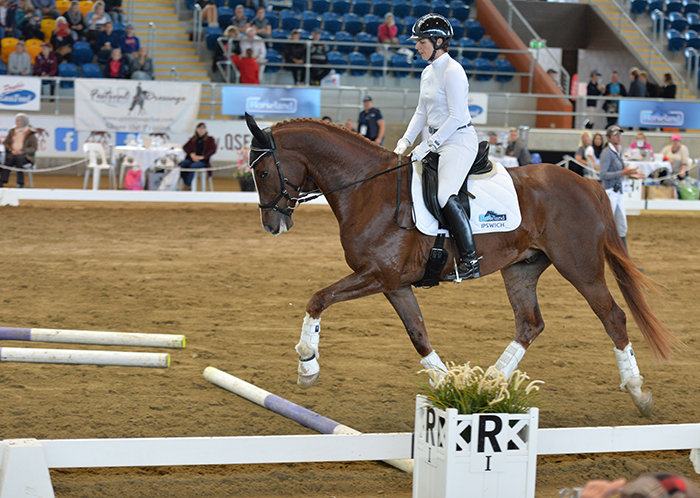
Exercise one – Poles are placed at R and P with tramlines at B.
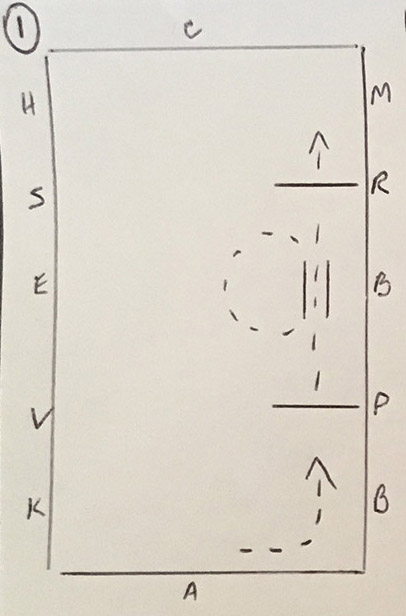
Objective: gentle introduction/warm up for greener horses, encouraging stretch, and focus. Tramlines can be used to measure accuracy in transitions, add a small circle at each pole, halts can be made inside tramlines also. Ride lengthening and shortening in tramlines for stride adjustability.
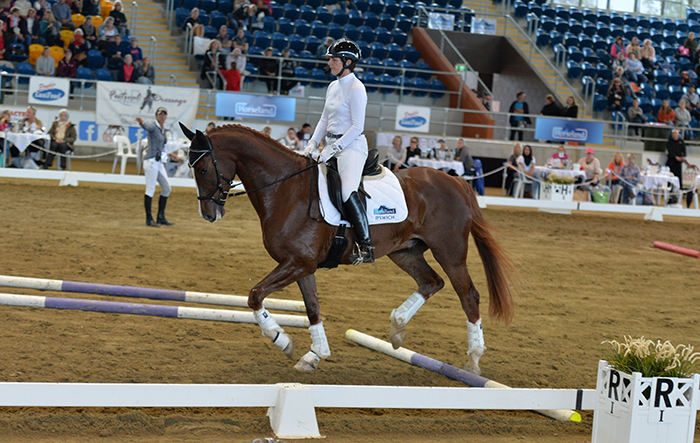
“When I am working over poles, I encourage the riders not to do too much to help the horse, we want to encourage the horse to make mistakes if necessary, and switch on.
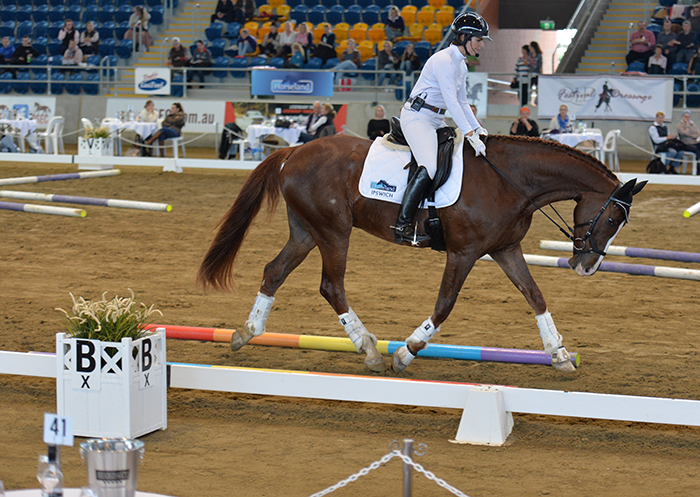
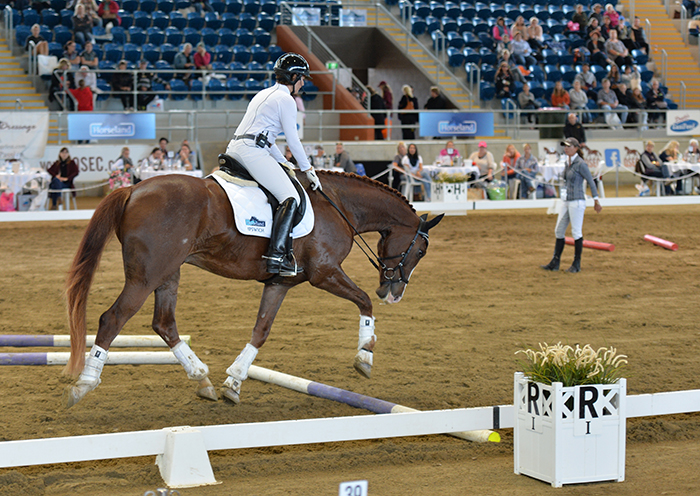
“With the tram lines, the parallel poles, we are working on stretching, it is important to keep the tempo slow and let the horse focus on the rail and process the exercise…”
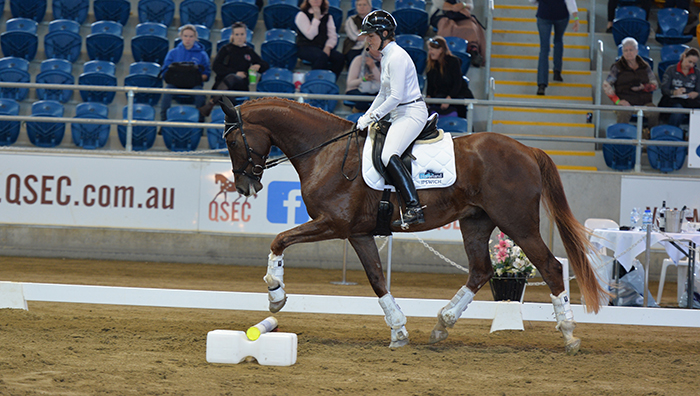
Poles placed on the twenty metre circle line at in a cross pattern.
Objective: Accuracy of line, consistency of tempo. Riders can alternate the line by leg yielding to different parts of the pole.The inside of the poles can be elevated to discourage shoulder loading.
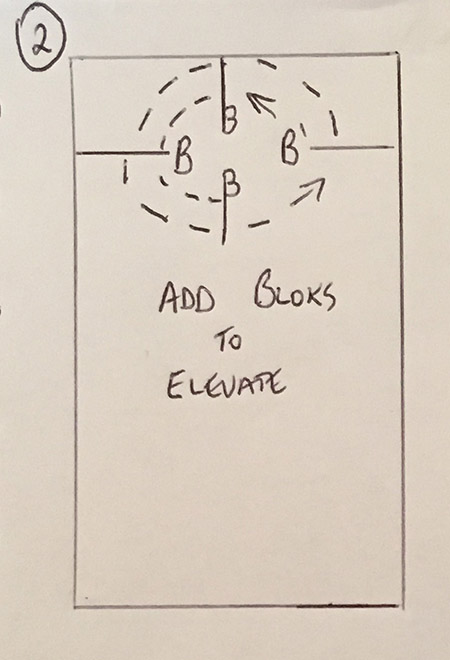
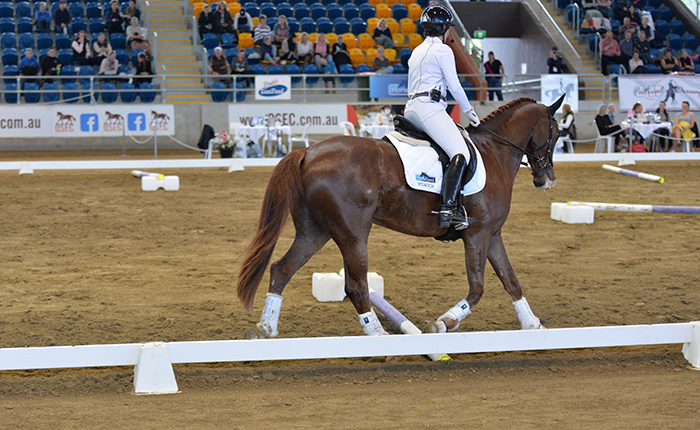
Young horses like to load their shoulders, so the poles on the circle are elevated on the inside. The poles are deliberately painted in three sections so the rider chooses which part she rides over – our main focus is consistency of line, consistency of tempo. Liz can move from riding on the outside panel to the inside, but there is still plenty of room for the horse to re-focus.”
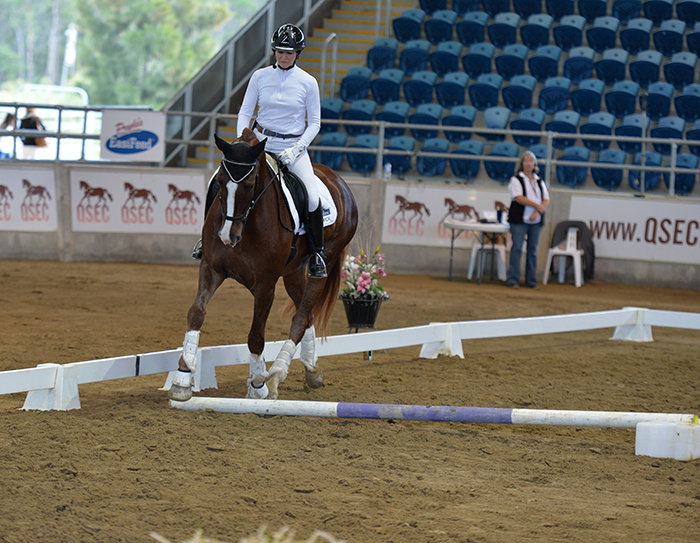
Next exercise. Liz worked over three sets of tramlines across the diagonal placed at seven metre intervals outwards from X
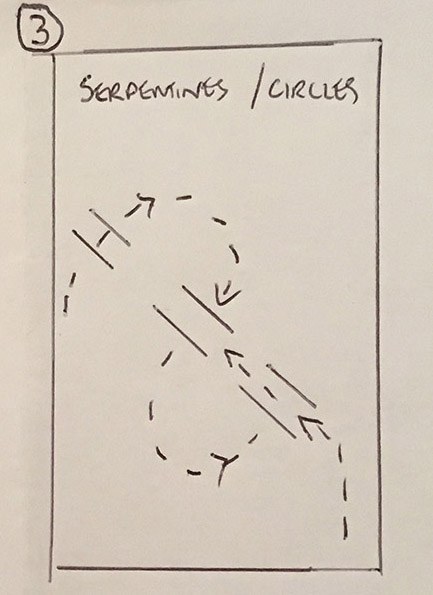
Objective: Latitudinal stretch, accuracy of line, suppleness…Ride serpentines, starting with the outside pair of tramlines, then adding the centre pair, mix it up by riding down the centre of the tramlines. Riders need to train their eyes for this one! You can also ride full circles incorporating the double sets of tramlines.
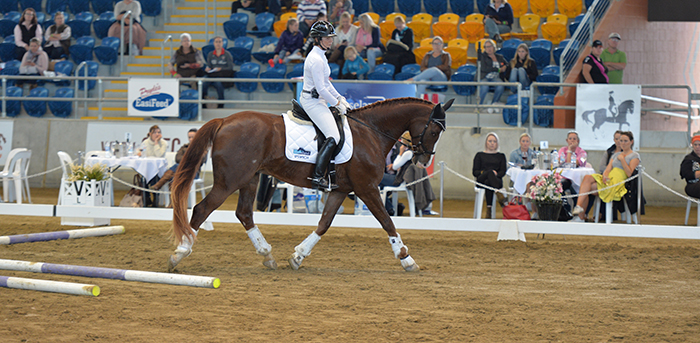
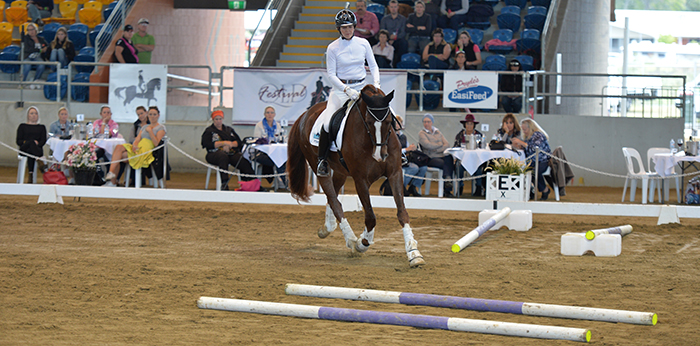
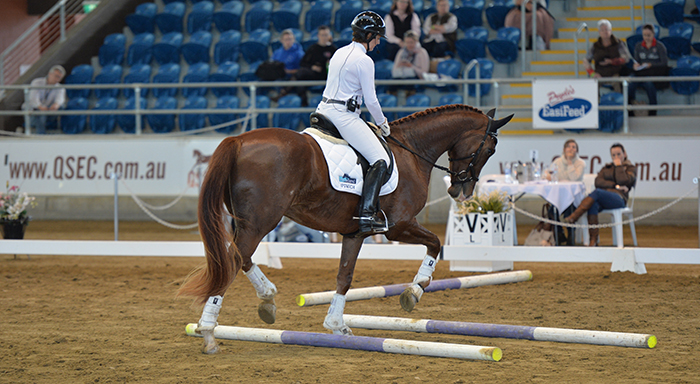
more follows
Next exercise: Elevated trot grid, every second pole lifted at opposite ends. Distance of 1.2m to 1.4m
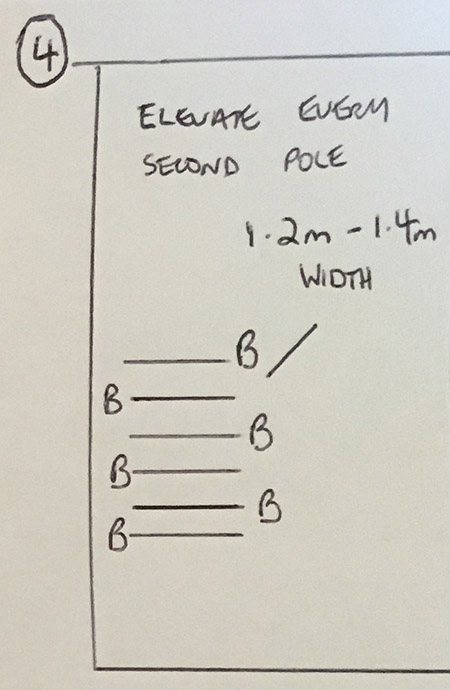
Objective: focus,encourage articulation of joints, create rhythm and cadence. Introduce the exercise with the poles on the ground, start with four then add a couple more. Elevate gradually… this is hard work for the horse! Place poles so that the horse has room to straighten in preparation for the exercise. Approach slowly, give the horse time to sight the rails and process the exercise. Distances can be shortened and lengthened, according to level of training and objectives.
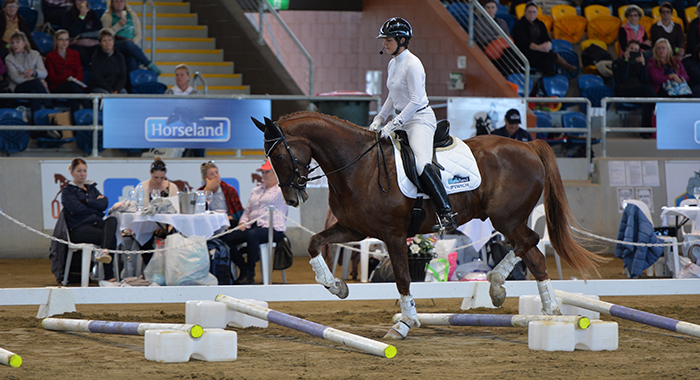
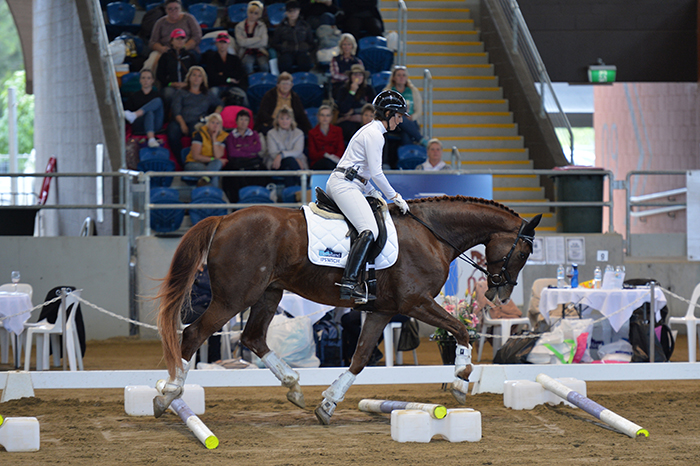
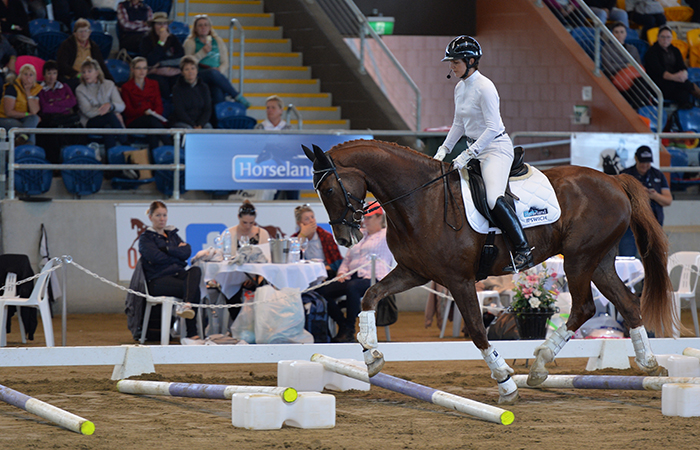
Liz is working up and down a set of rails, 1.4 metres apart, at first she is riding it on a longer stride, in a softer frame, they do that with ease, so Lesley wants more:
“Now we can play with the distances, shorten the stride, increase the elevation, set him up a little…”
And that is quite enough for one day for this big baby.
Next Liz’s spooky mare
Time for Liz’s Stella, now in her first season of Prix St Georges, we’ve moved from the giraffe to the compact model, a compact model that is more than a little spooky:
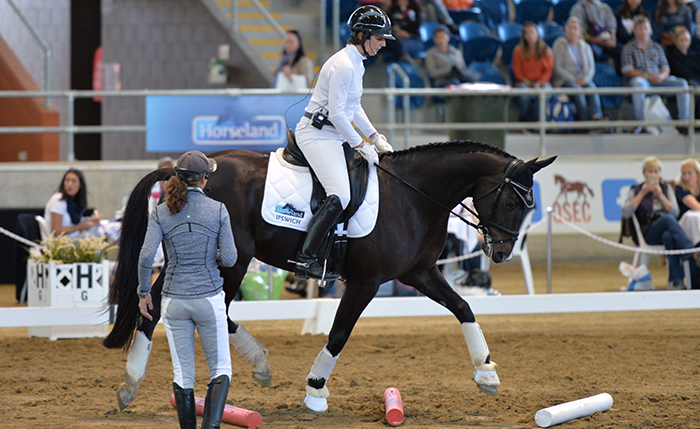
“One of the problems we’ve used the poles for is to counter the shying problem (Stella is doing her best to show that this is no fantasy) and we introduce the poles to create a fair bit of focus, quickly.”
Fan using short poles
Objective, accuracy, focus, balance and lateral stretch …great riding exercise, riders must ride the outside of the horse, can also be executed using longer poles for easier option.
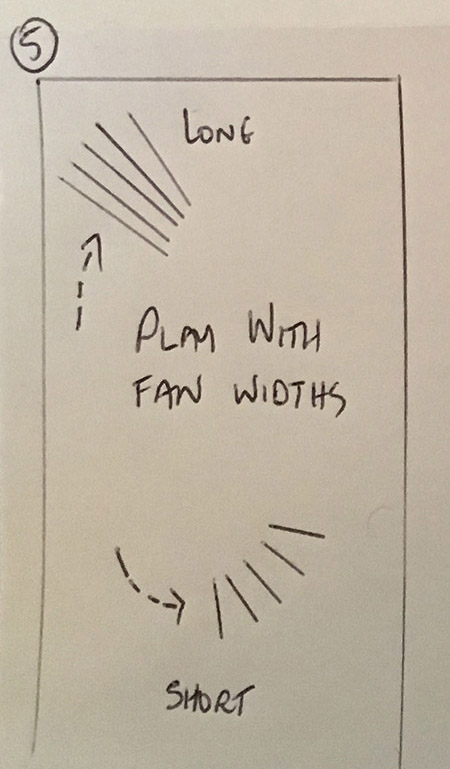
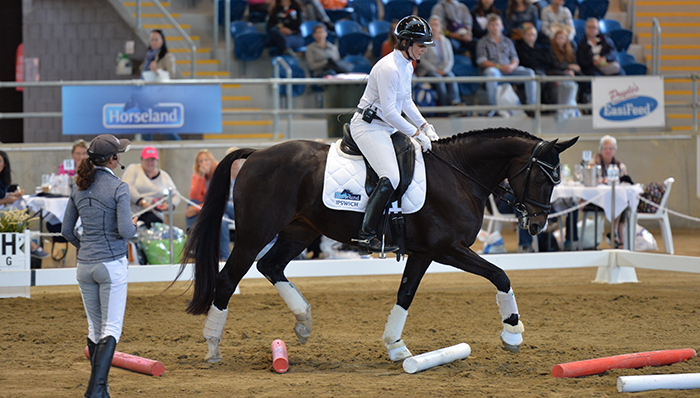
“I like the small fan exercise, it creates stretch down the outside of the horse, and is an accuracy test for the rider. Short poles mean the rider has to ride an accurate line at a slow rhythm – no rush.”
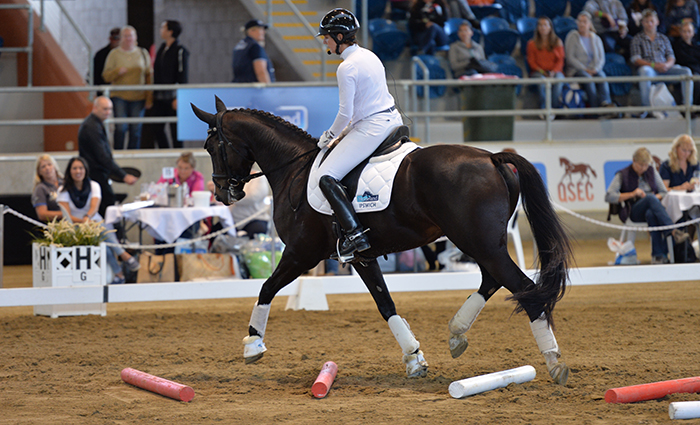
Next we’ve got two poles at R and P apart. Liz rides it first in 12 strides, then in 9…
Exercise: Counting canter strides – the poles are placed at R and P
Objective: stride adjustability, accuracy, poles can be placed closer together, play with stride count. Start with a working canter, then add more strides for collection, subtract for lengthening. The poles won’t lie!
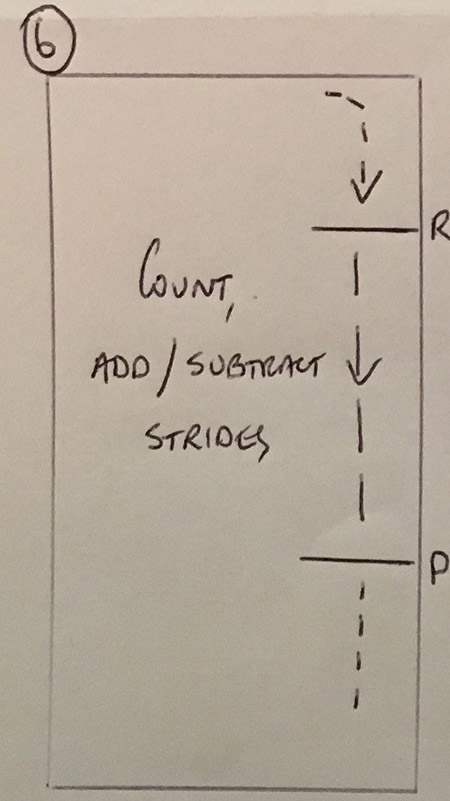
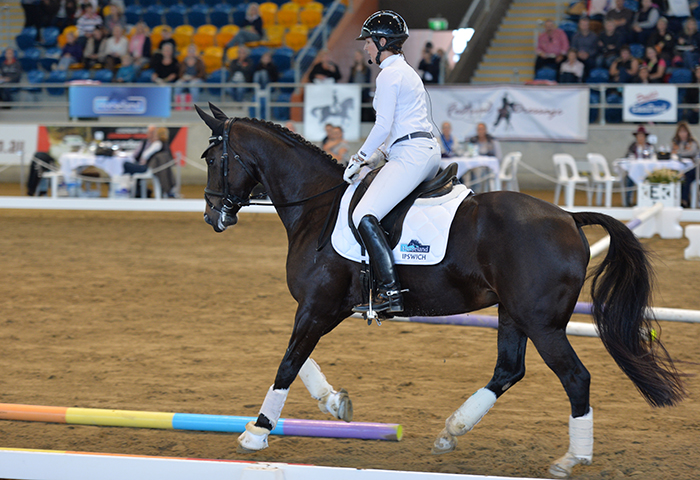
“You can play with this exercise for hours, it’s lots of fun.”
Next we talk to Leslie about her exercises…
Later I had a chance to sit down and chat with Leslie:
How is it that an honest eventing rider ends up working with the dressage queens?
“Actually Elizabeth Owens came to me a couple of years ago with a view to doing some pole work. I thought that was fabulous, and quite challenging, to work with a dressage rider because I was told in no uncertain terms that I was to keep the jumps at a certain height. I wasn’t actually used to being directed in my rôle…”
Liz is a strong lady…
“She is, but over the years we’ve come to a very nice agreement, which works really well. You probably noticed when we were in the ring today, there’s a bit of banter going, it’s lots of fun, but on a serious note, we feed off each other really well.”
Where did you get the idea of developing your cavalletti skills?
“I’ve always used cavalletti for my jumping horses, like most people. Even when I was young, I was into doing a lot of grid work and gymnastic exercises – probably more directed at creating a better jump than improving dressage movement. Over the years, as dressage has become more and more influential in eventing, and we had to reach a much higher standard now than we used to, I realised I was able to integrate the two.”
“Then working on the straight dressage with Liz and some others, it has become more and more apparent to me, how beneficial pole work can be for all performance horses.”
I guess you’ve read Ingrid Klimke’s book on cavalletti?
“Oh yes, she is such an icon, she is my equestrian hero, an inspiration. I have read her book but most of the exercises I use, I’ve developed myself.”
I was watching you with Liz, and they weren’t Ingrid’s exercises at all…
“They are my own ideas, I also really enjoy tailor making exercises for each individual horse. Obviously every horse has its strengths and weaknesses, so I cater to those, and I enjoy the process of tapping into my own creativity to come up with solutions.”
You’ve got nicely painted poles as well…
“I have. At home they are even better. It’s funny you mention that because I actually paint the poles in a very deliberate way at home, so the riders can target specific areas on the poles. It sounds pretty basic, but it is crucial that the rider learns to train his or her eye. I find that’s a strength of jumping riders but it is an area that dressage riders really need to work on. Obviously they haven’t been trained to use their eyes as specifically as jumping riders but it is just as necessary for the dressage riders if they are hoping to ride an accurate test.”
“My gymnastic exercises are really beneficial to the rider as well as the horse, but in a slightly different way, it’s a kind of cross training for the horse and the rider – just tapping into different ideas and getting the rider to think a little laterally. It gets the riders thinking outside the box.”
Do you have to test the exercises yourself? Do you ever think, this will be a really good exercise and it turns out to be a disaster…
“They don’t usually turn out to be complete train wrecks, but there have certainly been a few that needed some tweaking up. I’m always in that process of learning myself. Through the experimental phase, I am trying to gain more insight into how I can do it better – so yes, I tweak but it usually comes from trial and error.”
Are you working with eventers now?
“I actually do a lot with the inter-school movement up here. I’ve been working with Stuartholme Girls School for about nine years now. All the kids I coach do a lot of pole work and gymnastics, and it is amazing how quickly they develop the skills, and I think that feeds into their jumping and their dressage. We’ve got a team of about 30 at Stuartholme, and the standard in the Inter-School movement is now quite high. That has been another area that has been very stimulating.”
“But back to your original question – the eventers. I think everyone is more open now to the cross training principle with our horses. A lot of the eventers are so much more respectful of the dressage these days, and I think a lot of the straight dressage people are opening up to doing this sort of work. Let’s face it, if we are all supporting each other, and feeding each other ideas, we are going to elevate the level of all the disciplines.”
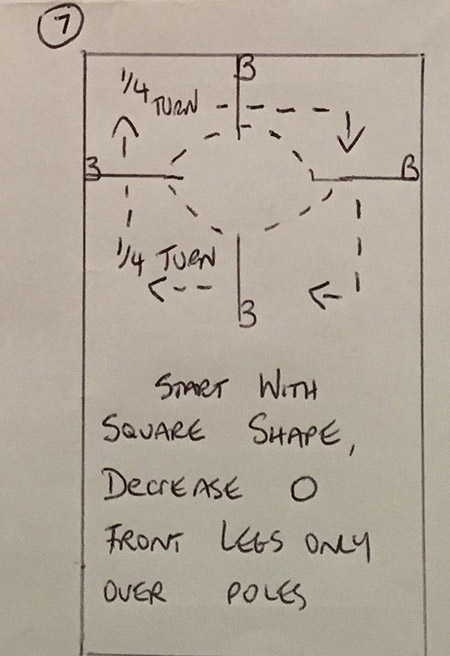
I thought it was interesting, the four poles with the quarter turns to develop the pirouette – yet, pirouette is not a movement you have ever ridden in one of your eventing tests… Where did that sequence come from?
Canter exercises using diagram above:
Objective: develop engagement, vertical energy. Poles can be elevated on the outside. Start with quarter turns on the haunches in the corners then move to travers on the inside line. Aim to place forelegs only, over each pole, but develop this. It is a tough one and requires very accurate riding. Gauge the horse’s fitness and don’t overdo it!
“It was really about creating more engagement in the back end – and getting horses to wait to the pole, that’s very relevant to jumping because, as you know, a lot of horses rush to their jumps, so the more we can teach them stride adjustability, sitting, waiting, engagement, it all reduces the tendency to rush their fences – then I just tweaked that up a bit to make it more relevant to the dressage pirouette.”
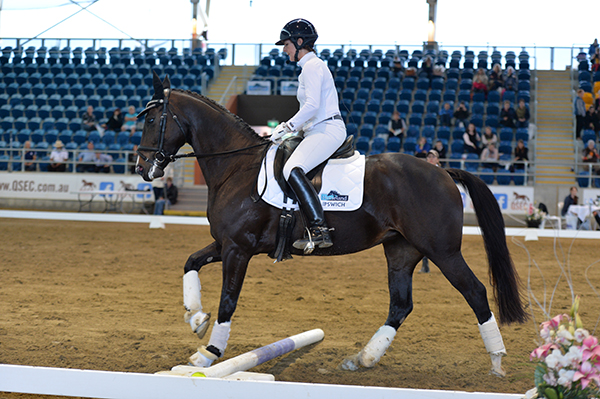
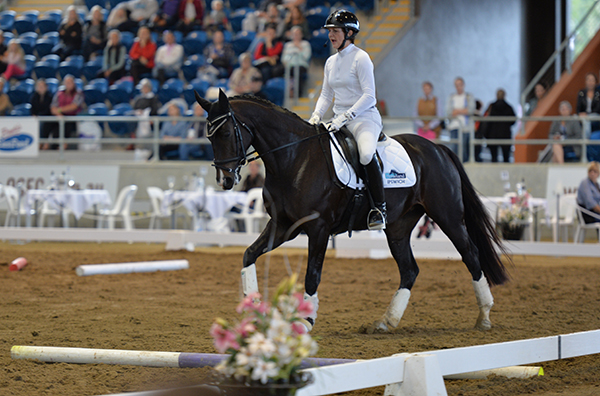
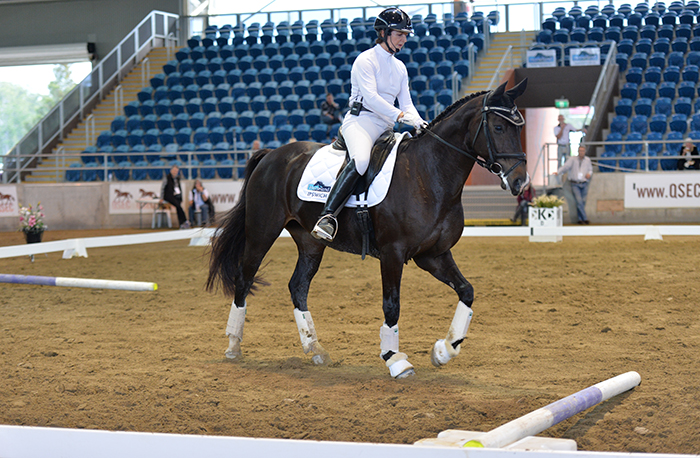
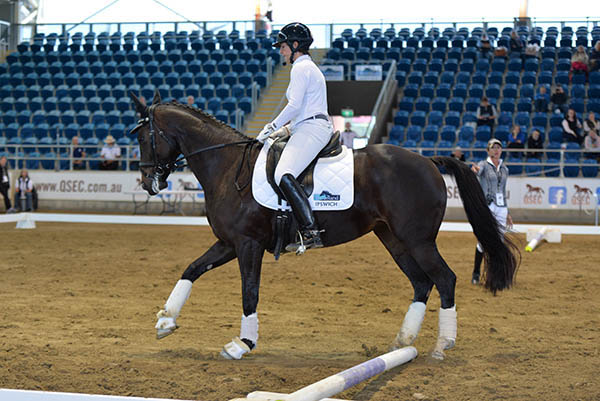
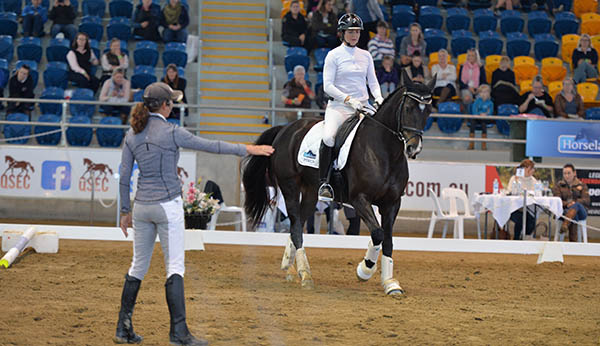
What do you do next – Piaffe?
“Well the elevated grids will elevate them more and more, and can certainly feed into the passage, it’s just creating more vertical energy in the trot, and there’s no reason that can’t feed into piaffe, I just have to come up with another cunning plan.”
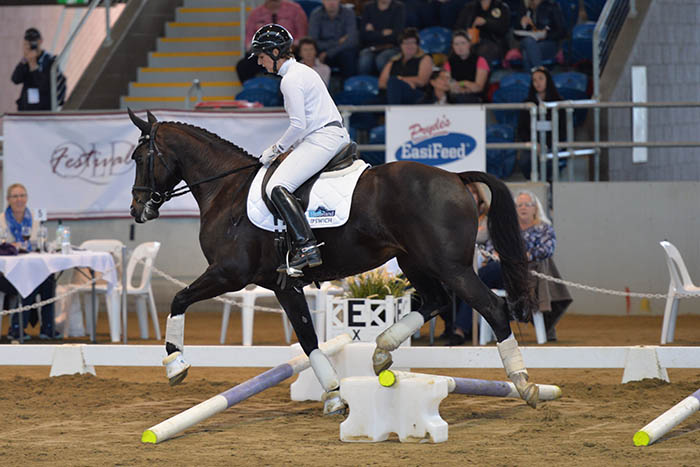
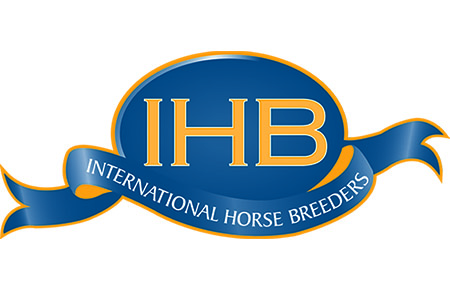
The fabulous stallions at Paul Schockemöhle International are available from International Horse Breeders. Go to www.ihb.com.au
Balou de Rouet
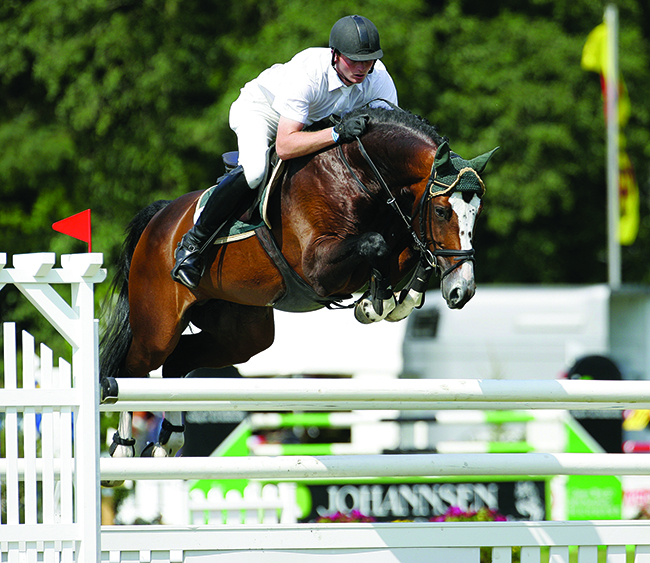
Diarado
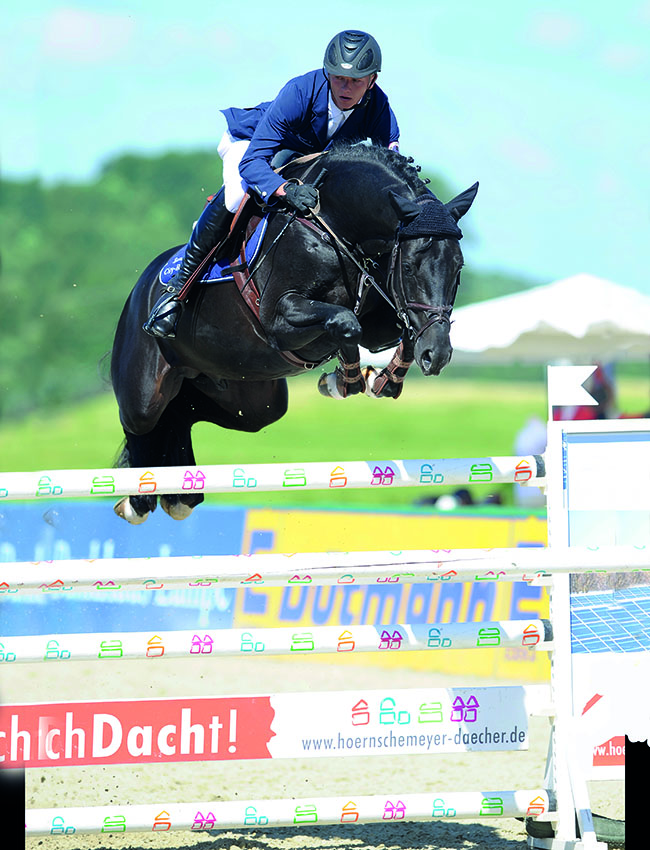

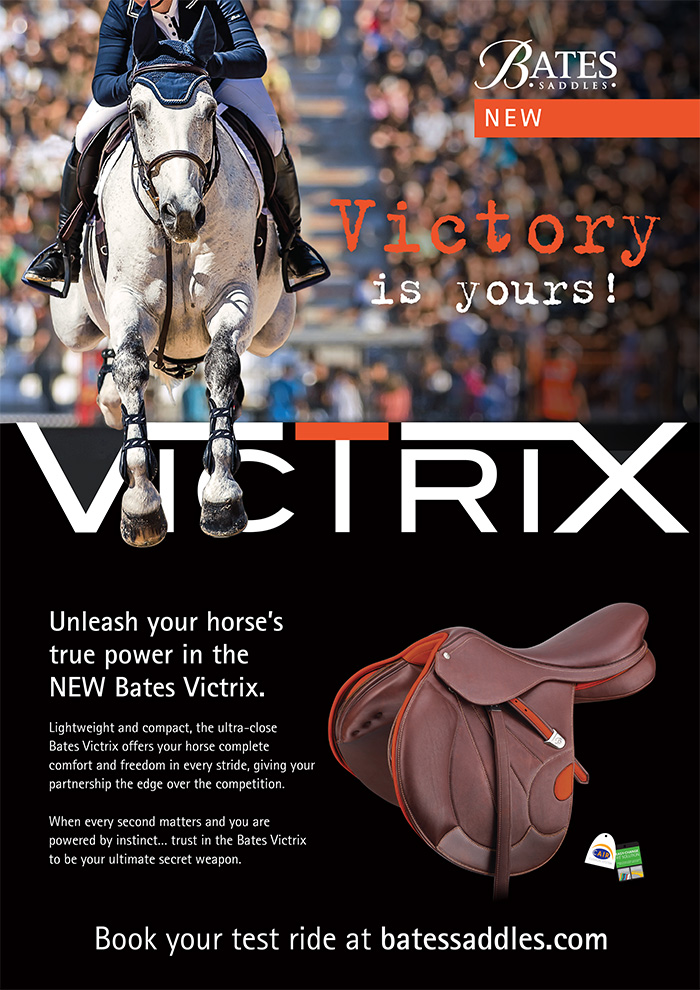
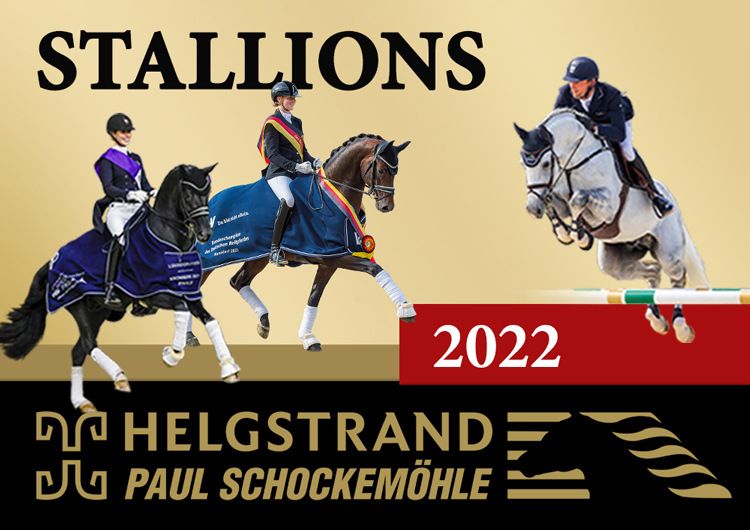
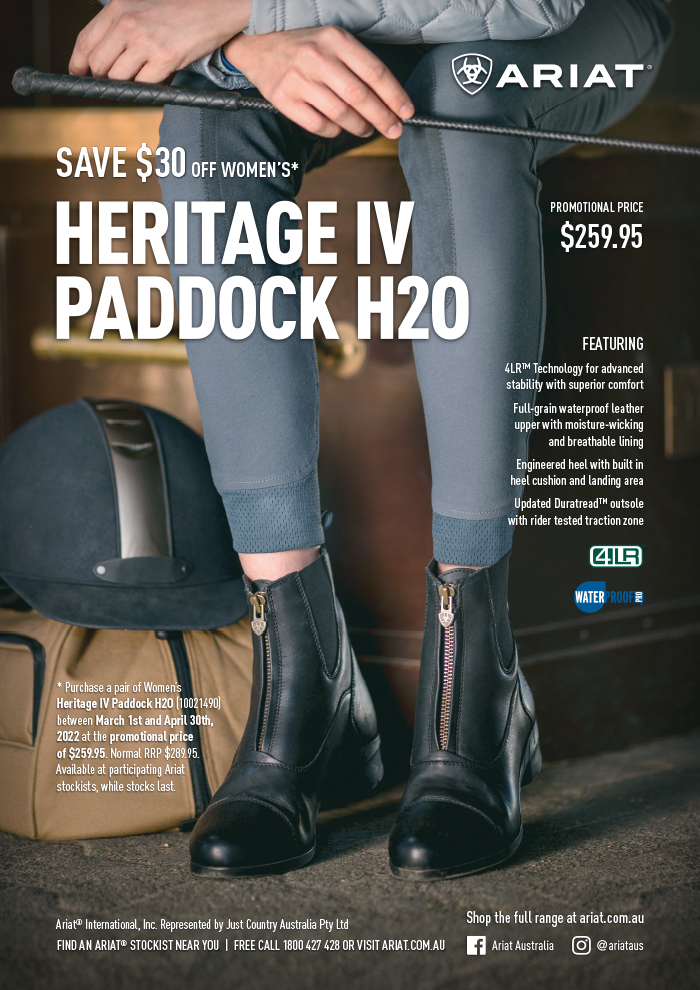
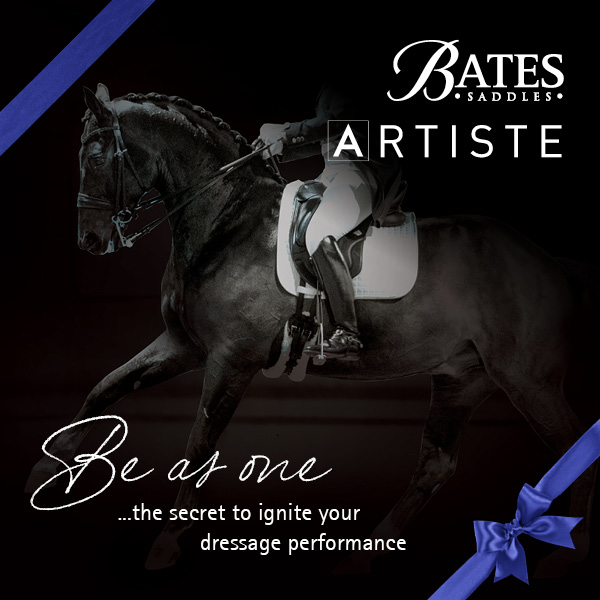
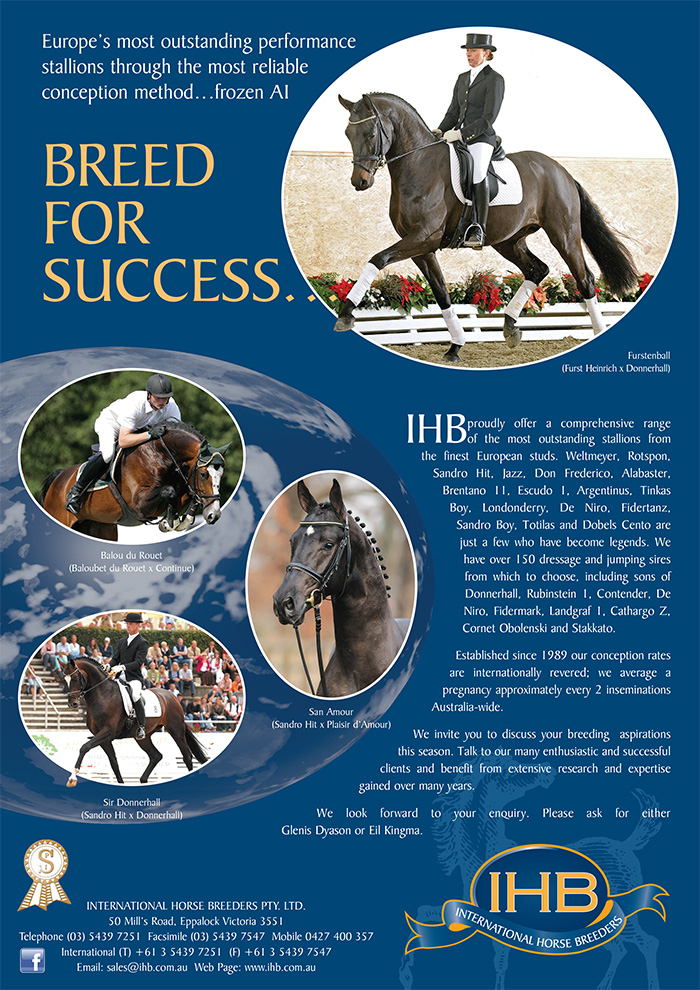
Great article with lots of cool ideas to play with – thank you!
Fiona Wallace – Fantastic article . Can’t wait to try and put some this into action with my boy Luey. I am keen to try the Fan concept as he is a little spooky. thanks Leslie. Great to see some thought provoking ideas.
I find dressage tedious and l am not that good
My horse also is a bit giraffe like naturally always looking around
So l am hoping this pole work may be the answer to help both of us
Thank you
Love the diagrams
Nita Eadie